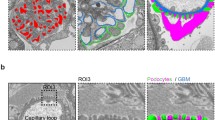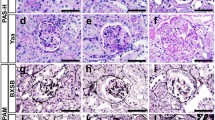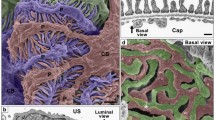Abstract
Background
The interaction among the glomerular components plays an important role in the development of glomerular lesions; thus, investigation of the ultrastructural three-dimensional (3D) configuration of the human glomerular cells and extracellular matrix (ECM) is important for understanding the pathogenesis of glomerulosclerosis, especially glomerulonephritis.
Methods
We applied a new technique of serial block-face scanning electron microscopy (SBF-SEM), which helps to acquire serial electron microscopic images to reconstruct a 3D ultrastructure, to a human kidney biopsy specimen obtained from a 25-year-old woman with lupus nephritis.
Results
SBF-SEM demonstrated that the cytoplasmic processes of the podocyte penetrated into the lamina densa of the glomerular basement membrane, and was in direct contact with the cytoplasm of mesangial cells at the site of mesangial interposition.
Conclusion
Although this is a single-case observational study, SBF-SEM revealed a unique 3D configuration, suggesting a novel mechanism of direct intercellular cross-communication between podocytes and mesangial cells, aside from the presumed paracrine communication.






Similar content being viewed by others
References
Pavenstadt H, Kriz W, Kretzler M. Cell biology of the glomerular podocyte. Physiol Rev. 2003;83:253–307.
Mene P, Simonson MS, Dunn MJ. Physiology of the mesangial cell. Physiol Rev. 1989;69:1347–424.
Schlondorff D, Banas B. The mesangial cell revisited: no cell is an island. J Am Soc Nephrol. 2009;20:1179–87.
Ohno N, Katoh M, Saitoh Y, Saitoh S, Ohno S. Three-dimensional volume imaging with electron microscopy toward connectome. Microscopy (Oxf). 2015;64:17–26.
Nguyen HB, Thai TQ, Saitoh S, Wu B, Saitoh Y, Shimo S, Fujitani H, Otobe H, Ohno N. Conductive resins improve charging and resolution of acquired images in electron microscopic volume imaging. Sci Rep. 2016;6:23721.
Thai TQ, Nguyen HB, Saitoh S, Wu B, Saitoh Y, Shimo S, Elewa YH, Ichii O, Kon Y, Takaki T, Joh K, Ohno N. Rapid specimen preparation to improve the throughput of electron microscopic volume imaging for three-dimensional analyses of subcellular ultrastructures with serial block-face scanning electron microscopy. Med Mol Morphol. 2016;49:154–62.
Cocks E, Taggart M, Rind FC, White K, Amira. A guide to analysis and reconstruction of serial block face scanning electron microscopy data. J Microsc. 2018; 1365–2818.
Dimke H, Maezawa Y, Quaggin SE. Crosstalk in glomerular injury and repair. Curr Opin Nephrol Hypertens. 2015;24:231–8.
Randles MJ, Collinson S, Starborg T, Mironov A, Krendel M, Konigshausen E, Sellin L, Roberts IS, Kadler KE, Miner JH, Lennon R. Three-dimensional electron microscopy reveals the evolution of glomerular barrier injury. Sci Rep. 2016;6:35068.
Joh K, Taguchi T, Shigematsu H, et al. Proposal of podocytic infolding glomerulopathy as a new disease entity: a review of 25 cases from nationwide research in Japan. Clin Exp Nephrol. 2008;12:421–31.
Bertuccio C, Veron D, Aggarwal PK, Holzman L, Tufro A. Vascular endothelial growth factor receptor 2 direct interaction with nephrin links VEGF-A signals to actin in kidney podocytes. J Biol Chem. 2011;286:39933–44.
Sison K, Eremina V, Baelde H, Min W, Hirashima M, Fantus IG, Quaggin SE. Glomerular structure and function require paracrine, not autocrine, VEGF-VEGFR-2 signaling. J Am Soc Nephrol. 2010;21:1691–701.
Dimke H, Sparks MA, Thomson BR, Frische S, Coffman TM, Quaggin SE. Tubulovascular cross-talk by vascular endothelial growth factor a maintains peritubular microvasculature in kidney. J Am Soc Nephrol. 2014;26:1027–38.
Eremina V, Sood M, Haigh J, Nagy A, Lajoie G, Ferrara N, Gerber HP, Kikkawa Y, Miner JH, Quaggin SE. Glomerular-specific alterations of VEGF-A expression lead to distinct congenital and acquired renal diseases. J Clin Invest. 2003;111:707–16.
Floege J, Eitner F, Alpers CE. A new look at platelet-derived growth factor in renal disease. J Am Soc Nephrol. 2008;19:12–23.
Titze B. Christel Genoud. Volume scanning electron microscopy for imaging biological ultrastructure. Biol Cell. 2016;108:307–23.
Acknowledgements
We thank Professor Kazuho Honda of the Department of Anatomy, Showa University School of Medicine for the critical reading and helpful suggestions; Drs. Truc Quynh Thai and Huy Bang Nguyen of the Division of Neurobiology and Bioinformatics, National Institute for Physiological Sciences, Okazaki, Japan for providing technical assistance; and Ms. Atsuko Imai of the Division of Cell Structure, National Institute for Physiological Sciences, Okazaki, Japan for her kind support in the segmentation and 3D techniques. The authors would like to thank Enago (http://www.enago.jp) for the English language review.
Funding
This work was partly supported by the JSPS KAKENHI Grant (number 26460449) to KJ; the Cooperative Research Program of Network Joint Research Center for Materials and Devices granted to KJ, MN, and TT; and a Grant-in-Aid for Scientific Research on Innovative Areas-Resource and technical support platforms for promoting research of Advanced Bioimaging Support (JP16H06280) to KJ, MN, and TT.
Author information
Authors and Affiliations
Contributions
MN was the attending physician of the patient. KJ, NO, and TT wrote the manuscript. NO, SS, and TT performed the genetic analyses. TT performed the observation with the TEM. NO, SS, and TT performed the observation with the SBF-SEM. KJ is a renal pathologist who helped diagnose the patient. All authors read and approved the final manuscript.
Corresponding author
Ethics declarations
Ethical approval
All procedures that involved human participants were performed in accordance with the ethical standards of the institution at which the study was conducted (IRB approval number 2015-1-514, Tohoku University School of Medicine) and with the 1964 Helsinki Declaration and its later amendments or comparable ethical standards.
Conflict of interest
The authors have declared that no conflict of interest exists.
Informed consent
Informed consent was obtained from all participants in the study.
Consent for publication
The patient gave informed consent for data publication.
Additional information
Publisher’s Note
Springer Nature remains neutral with regard to jurisdictional claims in published maps and institutional affiliations.
About this article
Cite this article
Takaki, T., Ohno, N., Saitoh, S. et al. Podocyte penetration of the glomerular basement membrane to contact on the mesangial cell at the lesion of mesangial interposition in lupus nephritis: a three-dimensional analysis by serial block-face scanning electron microscopy. Clin Exp Nephrol 23, 773–781 (2019). https://doi.org/10.1007/s10157-019-01701-0
Received:
Accepted:
Published:
Issue Date:
DOI: https://doi.org/10.1007/s10157-019-01701-0




